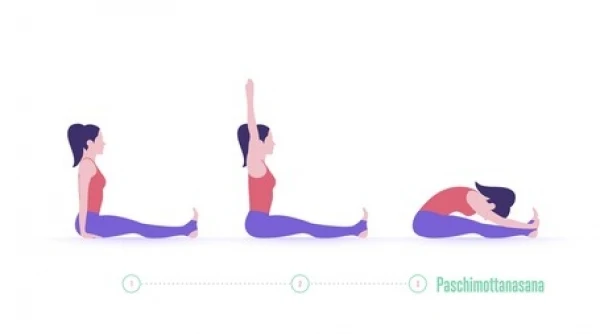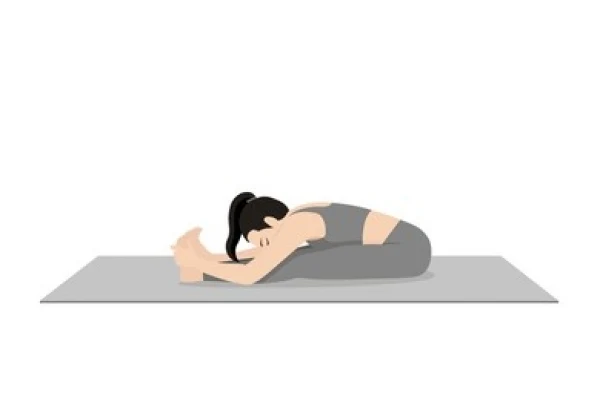Paschimothanasana, also known as Seated Forward Bend or Intense Dorsal Stretch, is a seated yoga pose that stretches the muscles in the back of the b
Paschimothanasana, also known as Seated Forward Bend or Intense Dorsal Stretch, is a seated yoga pose that stretches the muscles in the back of the body, including the spine, hamstrings, and calves. It is a great pose for improving flexibility, relieving stress and anxiety, and promoting relaxation.
 |
| paschimottanasana |
Procedure and Steps of paschimottanasana पश्चिमोत्तानासन (seated forward bend)
Here are the steps for performing Paschimothanasana:
 |
| paschimottanasana Steps |
- Begin by sitting on the floor with your legs extended straight in front of you. Keep your feet flexed and your toes pointing up.
- Inhale and lift your arms up above your head, stretching your spine upwards.
- Exhale and slowly hinge forward from the hips, keeping your spine straight as you reach towards your toes.
- Try to touch your toes or place your hands on your shins or ankles. If you cannot reach your toes, you can use a strap or towel to help.
- Hold the pose for several breaths, focusing on lengthening your spine and stretching the back of your legs.
- To release the pose, slowly lift your torso back up to a seated position, using your hands to support you if needed.
Benefits of paschimottanasana | paschimottanasana ke fayde
Here are some benefits of Paschimothanasana पश्चिमोत्तानासन:
- Stretches the muscles in the back of the body, including the spine, hamstrings, and calves.
- Improves flexibility in the back and legs.
- Relieves stress and anxiety.
- Promotes relaxation.
- Improves digestion and circulation.
- Helps to calm the mind and reduce fatigue.
What are the disadvantages of Paschimottanasana?
- Flexibility: This pose requires a certain level of flexibility in the hamstrings, lower back, and hips. If you are not very flexible, it may be difficult to fully extend in the forward bend. In this case, it is important to listen to your body's limits and only go as far as you can comfortably go, using props such as blankets or blocks to support your body as needed.
- Back injuries: If you have a history of back injuries or conditions such as sciatica or herniated discs, it is important to be cautious when practicing this pose and to consult with a healthcare professional or qualified yoga instructor before starting.
- Pregnancy: This pose is generally not recommended for women who are pregnant, as it may put pressure on the uterus and potentially strain the lower back.
- Headaches: If you are prone to getting headaches, this pose may exacerbate them due to the forward bend and pressure on the head.
- It is always important to listen to your body and practice with proper alignment to avoid strain or injury. If you have any concerns about your ability to practice this pose safely, it is best to consult with a healthcare professional or qualified yoga instructor.
 |
| paschimottanasana |
Precautions of paschimottanasana
Here are some precautions to keep in mind when practicing Paschimothanasana:
- Avoid practicing this pose if you have a back injury or chronic back pain.
- If you have tight hamstrings, be careful not to push yourself too far in the pose, as this can strain the muscles.
- If you have high blood pressure, be careful not to compress your chest too much in the forward bend.
- If you have knee injuries, be careful not to strain the knees by forcing them straight.
- If you have difficulty reaching your toes, use a strap or towel to help, or simply reach as far as you can without straining.
- If you experience any pain or discomfort while practicing this pose, stop immediately and seek the guidance of a qualified yoga instructor.
FAQs
Who should not practice Paschimottanasana?
- Individuals with a history of back injuries or problems
- Those with knee injuries or problems
- Pregnant women, especially in the later stages of pregnancy
- People with sciatica or herniated discs should avoid this pose or practice it with caution
- People with flexibility issues should avoid this pose or perform it with कॉशन
Does Paschimottanasana reduce belly fat?
Which disease is cured by Paschimottanasana?
Is Paschimottanasana good for back pain?
Is Paschimottanasana good for weight loss?
In final words, Paschimothanasana is a great pose for stretching the muscles in the back of the body and promoting relaxation. However, it's important to listen to your body and not push yourself too hard, especially if you have any injuries or medical conditions. As with any new exercise, it's a good idea to consult with a qualified yoga instructor or healthcare provider before beginning a new practice.









COMMENTS